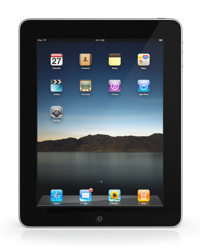[Every Friday, Mark Coddington sums up the week’s news about the future of news and the debates that grew up around them. —Josh]
 The iPad’s big reveal: Apple unveiled its new tablet — the unfortunately named iPad — on Wednesday, a week before the Super Bowl, and the buzz was as least as big: The Internet practically broke under the weight of the hype for Apple’s latest product. Rather than bury you in opinions about the specs and perks of the iPad, I’ll focus on what people are saying about the gadget’s potential impact on print and online media, especially journalism. Here goes:
The iPad’s big reveal: Apple unveiled its new tablet — the unfortunately named iPad — on Wednesday, a week before the Super Bowl, and the buzz was as least as big: The Internet practically broke under the weight of the hype for Apple’s latest product. Rather than bury you in opinions about the specs and perks of the iPad, I’ll focus on what people are saying about the gadget’s potential impact on print and online media, especially journalism. Here goes:
Let’s start with the runup. Print media folks had high hopes that the iPad would revolutionize their industries — even, as The New York Times put it, giving old media “a chance to undo mistakes of the past. In three smart posts, the tech sites TechCrunch, Gizmodo and Wired said the iPad could be a tool to change publishing, but, as Jason Kincaid in TechCrunch wrote, “someone will need to deliver the content.” Then there were the pre-emptive debunkers, who argued that the iPad would be “just another distribution platform,” merely a circulation tool for journalism, and a “massive distraction” for newsrooms.
After the announcement, the overwhelming reaction from the tech world was one of disappointment. The Guardian has a roundup, and you can itemized lists of iPad beefs by the web giants Mashable, Gizmodo and Gawker, as well as new-media-watcher Steve Yelvington. But there were a lot of people wowed and encouraged by the iPad announcement: A lot of them were old media people — publishers, as this MediaWeek roundup especially shows. As MediaCritic’s Scott Rosenberg observed, the iPad demo played largely to the delight of those who want to mimic the paper experience, but those who see the web as bringing in a new relationship with news seemed to expect more.
Wired and The Big Money gave us a medium-by-medium look at the iPad’s potential impact, and neither was blown away by its possibility for newspapers and magazines. Between the roundups of Poynter and Alan Mutter and the thoughts of Nieman Journalism Lab director Joshua Benton, we have a pretty good spectrum of sensible takes from media-watchers from a variety of backgrounds.
A few points in the discussion worth highlighting: A number of tech writers — Twitter engineer Alex Payne, Rafe Colburn and j-prof C.W. Anderson — have noted that the iPad is fundamentally a closed platform, designed more to secure market share for Apple than to perpetuate the web’s openness. (They’ve got a point.) Second, quite a few others have pointed out that the iPad is a content consumption device, not a content creation one. This has several implications: It appeals to a different audience than most new tech products (the casual, “lean-back” user, says Jason Fry; the content-inhaling youth of the world, says David Carr). It makes content creation critical (see TechCrunch and Wired), and, as NYU professor Jay Rosen put it, it turns the nature of the Internet from the “read write web” back into the “read only” web.
Ultimately, the iPad’s utility for journalism is going to come down to the quality of content that news organizations create for it. Is that content going to be regressive, trying to recreate a print experience and neutering the power of a new tool? Or is it going to be rich, web-native and innovative, giving users an experience and value they haven’t had until now? (Will Bunch, Judy Sims and Alan Jacobson make similar points quite succinctly and eloquently.)
—
 How leaky will the Times’ paywall be?: The biggest topic in journalism B.T. (Before Tablet) was The New York Times’ proposed paywall, and specifically, parsing the impact of Times execs’ statement that anyone coming to a Times article through “another Web site” will get free access to that article, without it counting toward their metered tally of page views. NYU professor Jay Rosen was the first to draw attention to the implications of that provision, concluding, “That looks a lot less like a pay wall to me. It isn’t a metered system if I can access the Times via the link economy without limit.”
How leaky will the Times’ paywall be?: The biggest topic in journalism B.T. (Before Tablet) was The New York Times’ proposed paywall, and specifically, parsing the impact of Times execs’ statement that anyone coming to a Times article through “another Web site” will get free access to that article, without it counting toward their metered tally of page views. NYU professor Jay Rosen was the first to draw attention to the implications of that provision, concluding, “That looks a lot less like a pay wall to me. It isn’t a metered system if I can access the Times via the link economy without limit.”
In that case, Reuters’ Felix Salmon argued, online subscribers would be paying not for the Times’ content, but for how they got to it. Or, as Josh Young put it, the Times is “charging for being ignorant of all doors but the front.” (Some more great back-and-forth on why the Times would want such a flimsy paywall can be found in the Notes and comments of Rosen’s piece.)
Silicon Valley Watcher Tom Foremski and Times contributor Robert Wright acknowledged the paywall’s leakiness, too: Foremski proposed getting linkers to run the Times’ ads, and Wright wanted to add micropayments to the paywall. Steve Yelvington pointed out another big hole in the Times’ metered model: cookies.
Felix Salmon and Gawker’s Gabriel Snyder did the math and found it doesn’t look good for the Times; The Big Money’s Frederic Fillouxwas more optimistic about the numbers, provided the Times only charges the heaviest users. (Salmon is also disappointed that the Times has given up on the dream of being so essential that it can make big bucks from a free site.) If you want to do some number-crunching of your own, the Nieman Journalism Lab’s Jonathan Stray has a nifty little tool for you.
—
Newsday’s 35 online subscribers: Based on sources from an internal meeting, The New York Observer reported the number of subscribers of Newsday’s website since the Long Island newspaper — the nation’s 11th-largest newspaper by print circulation — put up a paywall three months ago, and the tally shocked a lot media observers: 35. MediaDailyNews detailed Newsday’s overall decline in numbers since the wall went up in late October.
Several people — not least Newsday’s own execs — quickly noted the paper’s unique case: It’s owned by Cablevision, and subscribers of the print edition or Cablevision’s cable or broadband access get free access to the site. (The paper estimates that amounts to 75 percent of Long Islanders.) As Steve Yelvington noted and Newsday hinted to paidContent, the paywall is much more about giving a free perk to cable and Internet subscribers than actually netting paid website customers. So it doesn’t make much sense to apply this scenario to other similar-sized papers. That being said, 35 is an astonishingly low number, to say the least.
—
Foursquare’s possibilities for news orgs: Foursquare — a fast-growing, mobile-based social network based on sharing your location — announced its partnership with the free daily paper Canada Metro, the company’s first partnership with a news organization. Metro will add location-specific coverage to Foursquare users, who could receive alerts when they’re near those spots.
On the social media blog Mashable, Jennifer Van Grove described Metro’s Foursquare content as a travel guide book that “unlocks the best a neighborhood has to offer. She calls the relationship symbiotic (mobile utility for Metro, print exposure for Foursquare and local businesses). With mobile news access exploding, this could be part of a future-of-journalism recipe: The tech blog ReadWriteWeb has an intriguing vision of the type of location-aware news and tips that might be possible through services like Foursquare.
Last week, Lehigh j-prof Jeremy Littau said that Foursquare can allow journalists to map out pertinent facts about their communities and help residents explore their neighborhoods. And Sean Blanda advised The New York Times (and other news organizations) to learn from Foursquare’s system of rewarding users.
—
Taking action in Haiti: Last week’s discussion about whether reporters in Haiti should become involved in the story they’re covering (in this case, particularly reporters serving as doctors) continued into the weekend. The Society of Professional Journalists reiterated its stance that journalists should “avoid making themselves part of the stories they are reporting.” This prompted a barrage of angry Twitter posts by Jeff Jarvis. Tyler Dukes listed them and fired back at Jarvis, while Gazette Communications’ Steve Buttry joined Jarvis’ attack on SPJ. NPR’s “On the Media” brought in a few more takes, and St. Petersburg Times media critic Eric Deggans proposed a middle way: It’s OK to help, but turn the cameras off when you do it.
—
Reading roundup: If your head isn’t already spinning from the loads of iPad commentary I’ve thrown at you, there are a few pieces from the past week that are well worth a read: First, Alan Rusbridger, editor-in-chief of the British newspaper The Guardian, deftly outlined the state of journalism and argued against paywalls for news orgs in a lecture on Monday. Here’s the summary, the full text (it’s long) and a smart response by Jason Fry questioning Rusbridger’s anti-paywall argument.
Second, The New York Times’ Nick Bilton points out how ingrained sharing, filtering and aggregating have become in the way we live on the web. It’s one of those short, simple pieces that neatly captures a concept that many of us had noticed but hadn’t sharply articulated yet.
Finally, the Knight Digital Media Center’s Michele McLellan — also a fellow at the University of Missouri’s Reynolds Journalism Institute — has a mind-blowingly thorough taxonomy of local news organizations across the country. This is definitely a post you’ll want to save for future reference.